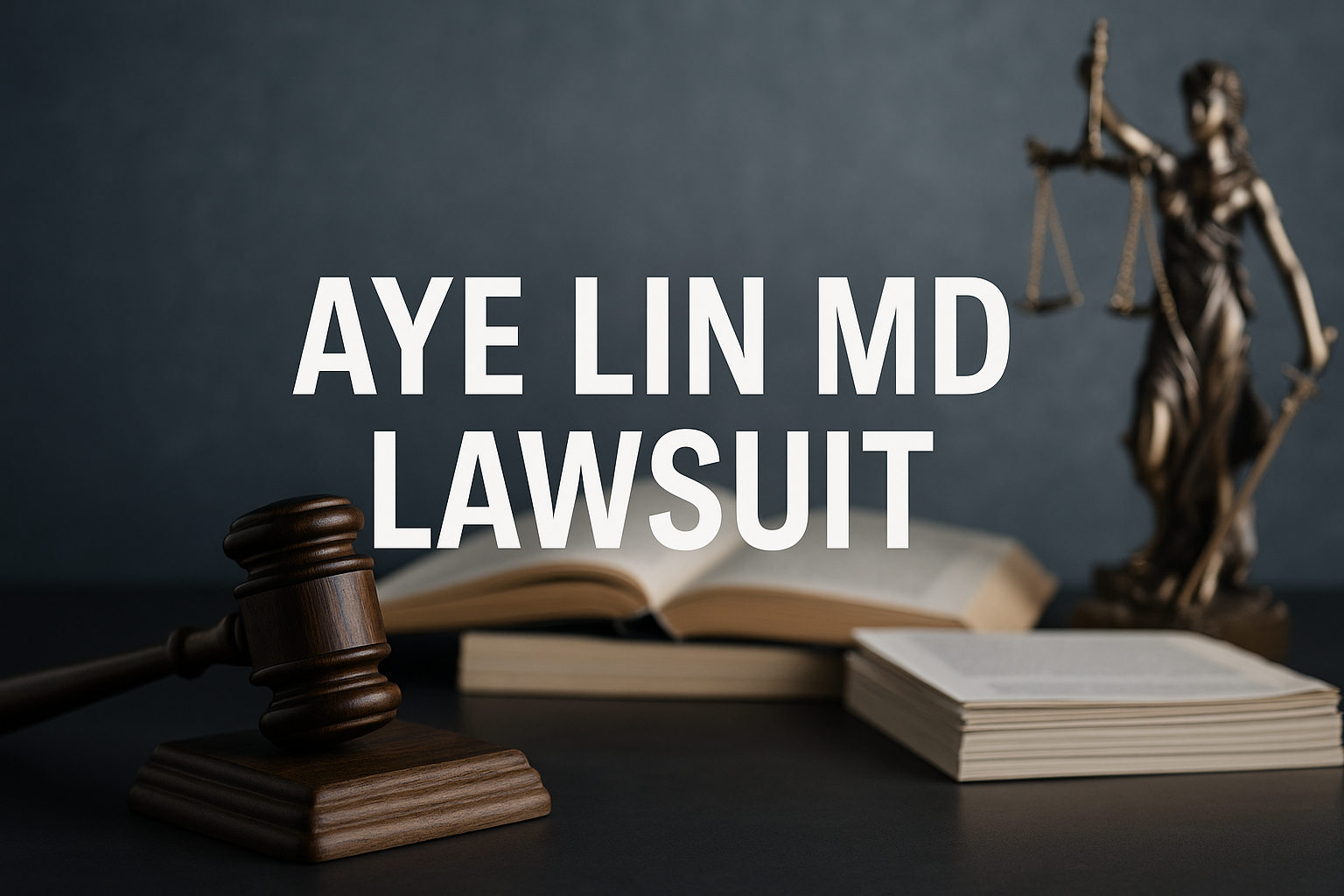Dr. Aye Lin built a strong name in the medical world. Patients trusted her. Colleagues respected her. She handled complex cases and gave people hope. Her work saved lives and shaped her reputation.
Now, that legacy hangs in the balance. A lawsuit threatens everything she worked for. Several patients claim she made serious mistakes. They accuse her of negligence and poor judgment. These claims now move through the court.
The case has drawn wide attention. News outlets report each update. Social media adds pressure. Many people follow the case closely. Some support Dr. Lin. Others demand accountability.
This legal fight could mark a turning point in her career. Her future as a doctor now depends on what happens next.
Who Is Dr. Aye Lin?
Dr. Aye Lin worked hard to reach the top of her field. She spent years studying, training, and helping patients. Her calm approach and steady hands earned her the trust of many. People often turned to her during their most difficult moments.
She handled each case with focus. Her patients felt heard. Her peers saw her as reliable and skilled. Over time, she became a leading name in her specialty.
Dr. Lin stood out not just for her knowledge, but for how she treated people. She made time for questions. She explained things clearly. Families felt safe under her care.
Now, that image faces damage. The lawsuit casts doubt on her past decisions. Her good name is under review. What once looked like a strong legacy now stands on shaky ground.
Why the Lawsuit Happened
The lawsuit began after several patients came forward. Each one shared a story of harm. They believe Dr. Lin made serious medical mistakes. These patients say she failed to act with proper care.
One person claims she gave the wrong diagnosis. Another says she performed a surgery that was not needed. A third says she failed to follow basic medical steps. These actions, they argue, led to pain, setbacks, and lasting damage.
They accuse Dr. Lin of ignoring accepted standards. In medicine, doctors must follow clear rules and proven methods. These patients say she did not. They now seek justice through the courts.
This kind of case falls under medical malpractice. It means a doctor may have caused harm by not doing what a skilled doctor should have done. The law takes these claims seriously.
What Medical Malpractice Mean
Medical malpractice is a serious legal issue. It happens when a doctor does not give the level of care expected in their field. Patient trust doctors to act with skill, care and good judgment. When that trust break the results can be harmful—or even deadly.
In this case, the patients claim Dr. Lin failed to meet those basic standards. They say her actions fell far below what any careful doctor would do. The law now requires them to prove two clear facts. First, that Dr. Lin did not follow accepted medical guidelines. Second, that her actions directly caused the harm they suffered.
This is not easy to prove. Courts do not rely on opinions alone. They expect strong evidence. That includes medical records, test results, and treatment plans. Expert doctors will also give their views. They will explain what Dr. Lin should have done—and where she may have gone wrong.
This type of case often takes time. Every detail matters. Each side will work to control the facts. In the end, the court will decide if Dr. Lin acted like a competent and responsible doctor—or not.
What the Plaintiffs Say
The patients involved in the lawsuit speak with urgency. Each one shares a personal account of pain and loss. They believe Dr. Lin made decisions that changed their lives for the worse.
One patient says she missed a serious illness. The delay in diagnosis gave the disease time to spread. Another describes a surgery that should never have happened. Instead of healing, the procedure caused more problems. It led to more treatment, more costs, and more suffering.
These patients say the harm was not just physical. It also affected their jobs, families, and mental health. Some lost time at work. Others faced long recoveries and emotional stress. They now ask the court to hold Dr. Lin responsible.
They seek financial compensation. This includes coverage for medical bills, missed wages, and the emotional toll of their experience. To them, this case is not just about money. It is about accountability.
How Dr. Lin Defends Herself
Dr. Lin firmly denies the accusations. She stands by her work. Her legal team says she acted with care, skill, and integrity. They argue that she followed the right steps in every case.
Her defense points to the nature of medicine. Not every treatment leads to success. Sometimes, even when a doctor does everything right, the outcome still turns out poorly. The defense says this does not prove wrongdoing.
They aim to show that Dr. Lin used sound clinical judgment. She made decisions based on the facts she had at the time. Her team will bring in medical experts to support her actions. They will argue that her choices matched accepted medical practices.
Dr. Lin’s lawyers also plan to highlight the risks of each procedure. Every treatment carries some level of danger. They say patients were informed. They say Dr. Lin did not ignore the rules—she followed them.
Her defense will try to raise doubt. If they succeed, the court may decide the case does not meet the legal standard for malpractice.
Legal Concepts That Matter
Standard of Care
This term means the level of skill a good doctor must use. The court will judge if Dr. Lin met that level. Experts in the field will give their views.
Burden of Proof
The patients must show clear links between Dr. Lin’s actions and their injuries. Her defense needs to break that link. If doubt exists, the court may not rule against her.
What’s at Stake for Dr. Lin
Dr. Lin faces more than just legal trouble. Her entire career is on the line. A ruling against her could lead to the loss of her medical license. That means she would no longer be allowed to treat patients or practice medicine.
Even if she wins the case, the damage may already be done. Trust is hard to rebuild. Her name now appears in headlines linked to malpractice. That alone can affect her future. Patients may choose other doctors. Some may avoid her out of fear or doubt.
Hospitals could also distance themselves. They may see her as a legal risk. Opportunities for promotions, research roles, or teaching positions may fade away. Once a doctor’s reputation comes under fire, the impact spreads fast.
In medicine, skill matters. But so does public image. A doctor must inspire confidence. If that trust breaks, recovery becomes much harder than any legal battle.
What This Means for Healthcare
This lawsuit may affect more than just Dr. Lin. It could push the entire healthcare system to make changes. Medical boards may take a closer look at how they manage complaints and mistakes. They may update the way they investigate doctors and handle discipline.
Hospitals might also react. They could tighten safety rules. Staff training may increase. Oversight of medical decisions could grow stronger. Leaders may ask more questions before approving high-risk treatments.
Insurance companies are also watching. A case like this can change how they assess risk. Some may raise costs for malpractice coverage. Others may demand stricter reporting from doctors.
This case shows the high pressure doctors face today. They work in fast-paced settings. One mistake—or even the appearance of one—can lead to legal action, media headlines, and career damage. The system must now weigh how to protect patients while also being fair to medical professionals.
Current Status of the Lawsuit
The legal process is still in motion. The case remains active in court. Dr. Lin and the plaintiffs continue to build their arguments. Both sides have already filed key documents and attended early hearings.
Pre-trial motions are underway. Each legal team wants to shape how the court handles evidence and testimony. Behind the scenes, lawyers review records, gather expert opinions, and prepare for trial.
No final ruling exists yet. The court has not made a decision. Complex cases like this often take time. The judge may need months to sort through facts, listen to witnesses, and reach a verdict.
The timeline remains uncertain. New developments may still arise. Both sides appear committed to fighting this case to the end.
Public Reaction and Media Focus
The case has drawn strong media interest. News outlets report each step. Headlines focus on the claims, the courtroom moments, and Dr. Lin’s response. Journalists frame the case as more than a legal fight—it reflects on the state of modern healthcare.
Dr. Lin is not an unknown figure. Her name carried weight in her field. That makes the case more personal for many people. Some stand behind her. They see her as a dedicated doctor caught in a tough situation. They believe she did her best in a high-risk job.
Others see things differently. They feel the system failed. They blame Dr. Lin for poor decisions. To them, the case reveals deeper flaws in how medicine works.
Public opinion stays divided. But one thing is clear: people want answers. They want safer care, more checks, and better systems. The lawsuit has forced new questions about trust, skill, and responsibility in medicine.
Conclusion
The Aye Lin MD lawsuit is more than a legal case. It reaches beyond one doctor and one courtroom. It touches the heart of how people see the medical world. Trust, once lost, is hard to earn back. This case puts that trust to the test.
The outcome may shift how future lawsuits unfold. Lawmakers might change how they define negligence. Medical boards may rethink how they check and discipline doctors. Hospitals may review how they prevent errors.
Doctors are watching. So are patients. Many now wonder what safety means in a hospital room. They ask how much risk is too much. They want care, but they also want protection from harm.
The court’s decision will speak to all of them. It could shape the future of medicine, law, and public trust. What happens next may set new rules—for every doctor and every patient.




